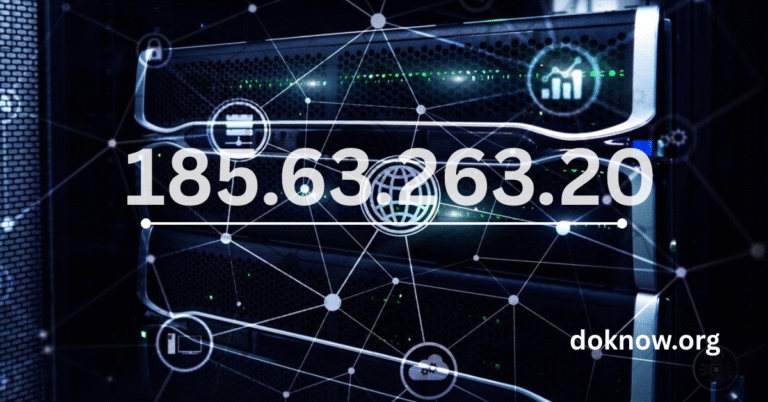Understanding 264.68.111.161 in Cybersecurity Context
In the vast digital landscape, IP addresses are the silent identifiers that power online communication. Among them, 264.68.111.161 stands out—not for its functionality, but for its anomaly. This IP address is technically invalid under IPv4 standards, yet it frequently appears in server logs, cybersecurity alerts, and network configurations. Why does this happen? Is it a typo, a spoofing attempt, or something more? In this article, we’ll explore the structure of IP addresses, dissect why 264.68.111.161 doesn’t conform, and uncover its implications for cybersecurity, software development, and network management. Whether you’re a tech enthusiast, IT professional, or simply curious, understanding this IP can sharpen your awareness of how digital systems operate—and how they sometimes misfire.
What Makes 264.68.111.161 an Invalid IP Address
IPv4 addresses consist of four octets, each ranging from 0 to 255. The first octet in 264.68.111.161 exceeds this limit, making it invalid.
- Valid IPv4 example: 192.168.0.1
- Invalid due to: First octet = 264 (>255)
- Result: Cannot be assigned to any device
This invalidity means it won’t respond to pings, won’t load in browsers, and won’t pass validation in network tools.
Technical Table: Analysis of IP Address
| Attribute | Description |
|---|---|
| IP Address | 264.68.111.161 |
| IP Version | IPv4 |
| Valid Format | ❌ Invalid (first octet exceeds allowed range of 0–255) |
| Common Appearance | Logs, email headers, test environments |
| Possible Causes | Typo, spoofing, placeholder, malformed input |
| Associated Risk | Minimal, but may signal cybersecurity anomalies or spoofed data |
| Use in Education | Used in tutorials and training as an invalid example |
| Developer Action | Flag input, validate format, replace with reserved test IPs |
| Firewall Response | Automatically blocked or ignored due to invalidity |
Why 264.68.111.161 Appears in Logs and Alerts
Despite being invalid, this IP often shows up in:
- Server logs
- Firewall alerts
- Email headers
Possible reasons include:
- Typographical errors
- Spoofing attempts by bots
- Placeholder data in test environments
- Glitches in tracking tools
Its presence may not indicate danger, but it’s worth investigating.
Cybersecurity Implications of 264.68.111.161
Invalid IPs like 264.68.111.161 can be used in:
- IP spoofing attacks
- Log injection attempts
- Phishing email headers
While the IP itself can’t send traffic, its appearance may signal malicious intent. Cybersecurity teams should monitor and validate such entries.
How Developers Handle Invalid IPs
Software developers often encounter malformed IPs during:
- Input validation
- API requests
- Log parsing
Best practices include:
- Using regex to validate IP format
- Flagging octets >255
- Replacing invalid IPs with reserved test ranges (e.g., 192.0.2.0/24)
This ensures systems remain stable and secure.
Network Admins and IP Address Management
For network administrators, spotting 264.68.111.161 means:
- Reviewing configuration files
- Auditing firewall rules
- Checking for spoofed traffic
Tools like IPAM (IP Address Management) help automate detection and prevent misconfigurations.
Educational Use of 264.68.111.161
In training environments, invalid IPs are used to:
- Teach IP structure
- Demonstrate validation errors
- Avoid accidental traffic routing
264.68.111.161 serves as a safe example that won’t interfere with real networks.
Testing and Placeholder Scenarios
Developers and testers may use 264.68.111.161 as:
- Dummy data in mock APIs
- Placeholder in documentation
- Example in tutorials
Its invalidity ensures no real-world impact, making it ideal for controlled environments.
Semantic SEO and Related Keywords
To improve visibility, include:
- Invalid IPv4 address
- IP spoofing
- Network configuration error
- Cybersecurity log analysis
- Placeholder IP address
These terms support semantic relevance without keyword stuffing.
Conclusion
The IP address 264.68.111.161 may seem like a random string of numbers, but it holds deeper significance in the world of digital infrastructure. Its invalid format makes it unusable in real-world networking, yet its frequent appearance in logs and alerts raises questions about spoofing, misconfiguration, and cybersecurity awareness. For developers, it’s a reminder to validate inputs. For network admins, it’s a cue to audit systems. And for educators, it’s a perfect teaching tool. Understanding why this IP is invalid—and how it’s used—can sharpen your digital literacy and improve your security posture. In a world where every byte matters, even a broken IP can tell a powerful story.
FAQs Section
Q. What is 264.68.111.161?
264.68.111.161 is an invalid IPv4 address. The first octet exceeds the maximum value of 255, making it unusable in standard networking protocols.
Q. Why does 264.68.111.161 show up in my logs?
It may appear due to spoofing, typographical errors, or placeholder data in test environments. It’s not tied to any real device.
Q. Is 264.68.111.161 dangerous?
Not inherently. However, its presence could indicate spoofing or log injection attempts. Always investigate its context.
Q. Can I block 264.68.111.161?
Yes. Most firewalls automatically reject invalid IPs, but manual blocking can add an extra layer of protection.
Q. How do I validate IP addresses properly?
Use regex or built-in functions to ensure each octet is between 0 and 255. Flag any entries that don’t conform.
Q. Is this IP used in cybersecurity training?
Yes. Invalid IPs like 264.68.111.161 are often used in educational materials to demonstrate proper validation and error handling.







